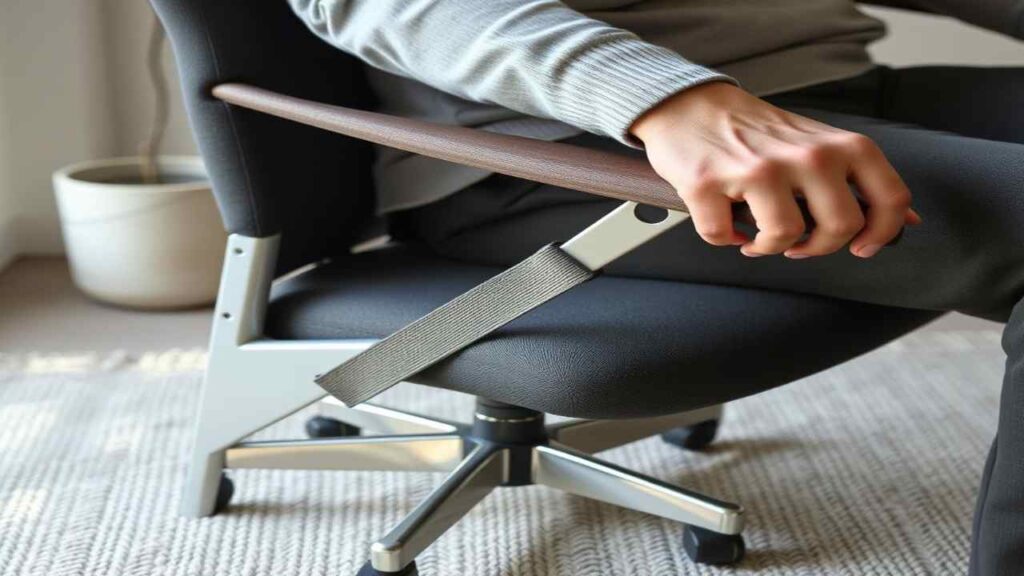Tension control is a feature that allows you to adjust the resistance of a chair’s backrest. This adjustment helps ensure that the backrest reclines according to your weight and preference, making your sitting experience more customized and comfortable.
How Does the Tension Control Feature Work?
The tension control feature typically consists of a knob or lever located beneath the chair seat. Here’s how it functions:

- Increase Tension: Turning the knob or adjusting the lever to the right increases the resistance, making the backrest more supportive. This setting is ideal for heavier users as reclining requires more effort.
- Decrease Tension: Turning the knob or adjusting the lever to the left decreases the resistance, making it easier to recline. This setting is suitable for lighter users.
By adjusting the tension, you can ensure the chair’s backrest offers the proper support for your body weight and sitting habits.
Benefits of Using Tension Control
- Promotes Better Posture: Adjust your weight and sitting habits to help maintain proper posture.
- Personalized Comfort: This allows you to fine-tune the level of back support to meet your individual needs.
- Reduces Back Strain: Ensures the chair supports the natural curvature of your spine, minimizing discomfort and strain.
- Enhances Productivity: A comfortable sitting experience can improve focus and productivity.
Tips for Effectively Using the Tension Control Feature

- Start Upright: Always begin with the chair upright before adjusting the tension control.
- Gradual Adjustment: Use the knob or lever to gradually increase or decrease the tension based on your comfort level.
- Test Recline: After each adjustment, test the recline function to ensure the backrest provides the desired support without causing strain.
- Regular Reassessment: Periodically reassess and readjust the tension control to accommodate changes in your weight or sitting habits.
- Communicate for Shared Chairs: If the chair is shared, communicate how to adjust the tension control so each user can customize their sitting experience.
Visual Demonstration
A visual demonstration can make understanding and adjusting the tension control feature easier. Here are a few suggestions:
- Instructional Video: Create a video showing the location of the tension control knob or lever and how to use it.
- Step-by-Step Guide: Provide a guide with clear images depicting the knob or lever, its turning direction, and the resulting change in backrest resistance.
- Infographics: Use infographics to highlight correct posture while adjusting the tension control and recommend settings for different user weights.
- Before-and-After Images: Show the backrest at different tension settings to illustrate the change in recline resistance.
User Manual Section on Tension Control
Tension Control Feature User Manual
The tension control feature on your chair allows you to customize the resistance of the backrest to your weight and sitting preference. Here’s how to effectively use this feature for a more comfortable and supportive sitting experience:
- Locating the Tension Control:
- Underneath the seat, you will find a knob or lever. This is the tension control mechanism.
- Adjusting the Tension:
- Begin by sitting upright in your chair.
- Turn the knob or adjust the lever to the right to increase tension for more support, suitable for heavier users.
- Turn the knob or adjust the lever to the left to decrease tension for easier reclining, which is ideal for lighter users.
- Testing and Fine-Tuning:
- After each adjustment, test the recline function by leaning back in the chair to assess the level of support and comfort.
- Adjust the tension until you find the setting that best supports your back and provides a comfortable sitting experience.

- Regular Maintenance:
- Periodically reassess the tension control setting to accommodate any changes in your weight or sitting habits.
- If the tension adjustment becomes too loose or tight over time, readjust the control to maintain the desired level of support.
Remember, the tension control feature promotes proper posture and support. It’s essential to use this feature to tailor your chair’s backrest resistance to your needs for a healthier and more comfortable sitting experience.











